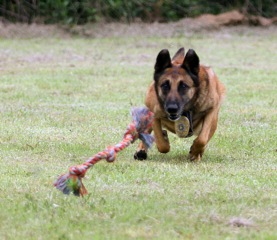
PHOTO: David Latimer
One way to test your dog’s self-confidence and independence is to simply enter a room and release your dog. Give the command to search, and watch the reaction. If your dog immediately moves away from you and engages in search behavior, you probably have a self-confident and self-reliant dog. If your dog looks at you quizzically and is obviously unsure of what to do, your dog may have become overly reliant on your direction and control. There are other indicators of course, as we’ve discussed in this series, but this one is a quick and easy test.
One exercise that I’ve used successfully through the years, for dogs that are overly dependent on the handler, is to place a hide near the door into a small room. Have the handler enter the room and close the door, then release the dog and give the dog the command to engage in search activity.
If the dog doesn’t immediately start to sniff and search, have the handler quietly take it out of the room and put it away — do not allow punishment in any form other than quietly taking the dog and putting it in its crate. Do not jerk the leash or speak harshly to the dog. Have the handler stay out of the room as well. Aversion training is difficult to incorporate into scent detection training, and at this point, the dog would likely have no idea why it is being punished.
While the dog is in its crate and the handler is out of the room, go back in the room and place a food treat (if the dog is rewarded with food) or the dog’s toy (if it’s toy rewarded) as near as possible to the hide. Bring the dog back in, release it and and try to reengage the search somewhere near the hide. When the dog discovers the toy or food and the hide, toss an additional reward immediately, and praise profusely for its success. Put the dog away again, move the hide, and replace the toy or piece of food.
Repeat this in other rooms until it becomes obvious that the dog is searching without excessive direction or commands. The search should be made gradually more complex and difficult as the dog gains confidence. Eventually, you’ll also want to return to the dog searching on leash, since that is often the safest way to conduct a search in a new area.
As a quick aside here, many of us spend a lot of time talking about and investigating odor behavior, studying vapor densities, participating in discussions of how particulates move as compared to vapor-based odors, the chemical compositions of odor, air currents, obstructions and how such things effect odor movement. That’s all impressive knowledge to talk about from an academic perspective, but if we want to develop great search dogs, we should also be figuring out how to set up training scenarios where the dog is encouraged to learn odor behavior and how to best track its movement. After all, the dog is the only member of the team capable of doing so.
Building your dog’s self-confidence and increasing mutual trust between you and your dog you will make a good detector dog team into a great detector dog team.
Leave A Comment